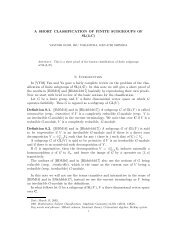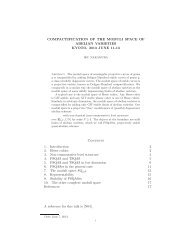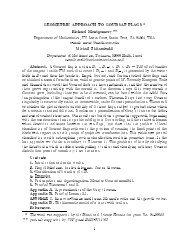mckay correspondence iku nakamura
mckay correspondence iku nakamura
mckay correspondence iku nakamura
- No tags were found...
Create successful ePaper yourself
Turn your PDF publications into a flip-book with our unique Google optimized e-Paper software.
16 IKU NAKAMURAthe deformation to a small disc of the (s, t) space near the origin in the complextopology). In other words, Z is deformed into a G-invariant reducedsubscheme of A 2 . Therefore Z, hence I, belongs to Hilb G (A 2 ).4.3.3. Since I belongs to Hilb G (A 2 ), any deformation I ′ of I over a connectedbase belongs to Hilb G (A 2 ) because Hilb G (A 2 ) is connected. In particular,I(W ) defined above and all I ′ we are going to construct in this (sub)sectionbelong to Hilb G (A 2 ).4.3.4. Next we consider the case where W = V 6 (ρ 1 ). Let W ∞ = V 6 (ρ 1 ) andW t =(xy + t(x 6 − y 6 ))S + n. Then lim t→∞ W t = W ∞ in P 1 = P(V (ρ 1 )) =P(V 2 (ρ 1 ) ⊕ V 6 (ρ 1 )). Now we compute lim t→∞ I(W t ) in Hilb G (A 2 ). For any t,hence for t = ∞ we have5∑5∑I(W t )/n = W t + S k W t + n/n = W t + S k V 2 (ρ 1 )+n/n,k=1I(W ∞ )/n = V 6 (ρ 1 )+k=15∑S k V 2 (ρ 1 )+n/n ≃ ∑k=1ρ∈Irr Gdeg(ρ)ρ.Since I(W ∞ ) is a limit of I(W t ), to be more precise, we have a flat familyover P 1 deforming I(W t )intoI(W ∞ ), the limit I(W ∞ ) belongs to Hilb G (A 2 ).We note thatV (I(W ∞ )) = V 6 (ρ 1 )+S 1 V 2 (ρ 1 )=V 6 (ρ 1 )+S 3 (ρ 2 ).Hence I(W ∞ ) belongs to the subset P (ρ 1 ,ρ 2 ) of Hilb G (A 2 ).4.3.5. Now we shall prove the converse. Let I ∈ Hilb |G| (A 2 ) G−inv . SupposeS/I ≃ C[G] and ρ 1 ⊂ V (I). Then n ⊂ I by (the same reason as) Corollary 2.7.This implies that a nonzero G-submodule W of V 2 (ρ 1 ) ⊕ V 6 (ρ 1 ) is containedin V (I), and in I as part of generators of I. IfW ≠ V 6 (ρ 1 ), then I containsI(W ) defined above. Since I(W )/n ≃ I/n, we have I = I(W ). SupposeW = W ∞ = V 6 (ρ 1 ), or equivalently V 6 (ρ 1 ) ⊂ V (I). Since W is part ofgenerators of I, V 5 (ρ 2 ) is not contained in I. There are only V 3 (ρ 2 ) andV 5 (ρ 2 )inS(m/n)[ρ 2 ]. Hence V (I) ⊃{x 2 y +ty 5 ,xy 2 −tx 5 } for some t, whencet{x 6 , −y 6 } + n ⊂ S 1 V (I) +n ⊂ I because x 2 y 2 ∈ n. If t ≠ 0, this impliesthat {x 6 , −y 6 } = V 6 (ρ 1 ) is not part of generators of I, which contradictsthe assumption W = V 6 (ρ 1 ). It follows that t = 0, and V 3 (ρ 2 ) is containedin I. Let I(W ) = I(W ∞ )=I(V 6 (ρ 1 )) := V 6 (ρ 1 )S + V 3 (ρ 2 )S + n. ThenI(W ∞ ) ⊂ I. As we saw above, I(W ∞ ) ∈ Hilb G (A 2 ) and I(W ∞ )/n ≃ C[G].Hence I(W ∞ )/n ≃ I/n, whence I = I(W ∞ ).Thus we have proved that if S/I ≃ C[G] and V (I) ⊃ ρ 1 , then I = I(W )for some nonzero G-submodule W ⊂ V 2 (ρ 1 ) ⊕ V 6 (ρ 1 ).





